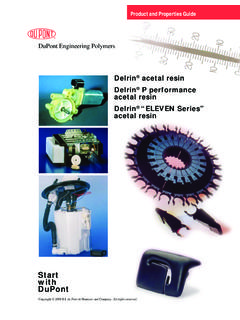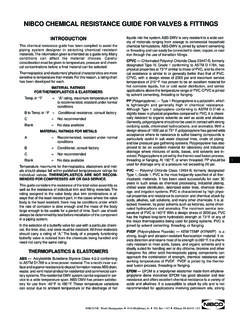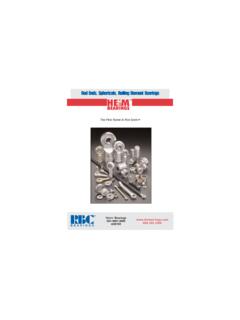Transcription of PTFE and PFA - Emerson
1 White PaperPTFE and PFA Similarities and Differences White Paper1 ptfe and PFA Similarities and DifferencesIntroductionThe purpose of this document is to define and compare two of the most used fluoropolymers, ptfe and PFA, in industry globally and clarify the differences between ptfe and PFAP olytetrafluoroethylene ( ptfe ) is a synthetic fluoropolymer of tetrafluoroethylene that has numerous applications. The most widely known ptfe formulation is sold under the brand name of teflon . ptfe was discovered by dupont Co. in alkanes (PFA) is a copolymer of hexafluoropropylene and perfluoroethers.
2 It was developed after the discovery of ptfe by the same producer ( dupont Co.). One commonly known PFA formulation is teflon has very similar properties to ptfe , though the biggest difference between ptfe and PFA is that PFA is melt-processed. This is accomplished through conventional injection molding as well as screw extrusion of usePTFE is popularly used as a non-stick coating for pans and many modern items of cookware. ptfe is often used in containers and pipes for handling reactive and corrosive chemicals. This is because it has non-reactive properties. Another practical application of ptfe is as a lubricant.
3 Used in this way, ptfe helps to reduce friction within machinery, minimize the wear and tear, and improve energy is generally used for plastic lab equipment because of its extreme resistance to chemical attack, optical transparency, and overall flexibility. PFA is also often used as tubing for handling critical or highly corrosive processes. Other applications for PFA are as sheet linings for chemical equipment. Because of its properties, it can facilitate the use of carbon steel fiber reinforced plastics (FRPs) as replacements for more expensive alloys and used for level measurement are frequently exposed to harsh tank atmospheres.
4 Aggressive media, such as acid, can corrode probes and parts in contact with the product. Viscous and sticky products are other level measurement challenges. These can cause build-up on the wetted parts of the transmitter and increase the risk of affecting the measurement. Wetted parts coated in ptfe or PFA materials provide a good resistance to corrosive products and are an effective solution for avoiding contamination caused by product PaperPTFE and PFA - Similarities and DifferencesWater based products can cause condensation on the antenna, that might affect the level measurement.
5 Due to the hydrophobic properties of ptfe and PFA, the measurement will remain unaffected in case droplets of water build-up on the antenna 1. Level Measurement Devices Coated in ptfe or PFA MaterialDifferences between ptfe and PFAPTFE, being a fluorocarbon solid, is hydrophobic, meaning that it is less easily wetted by substances containing water. Also, ptfe possesses a very low coefficient of friction when in contact with is superior to ptfe in terms of flexibility particularly when it comes to tubing applications. On the other hand, PFA s flex life ( , capacity to endure repetitive folding) is lower than is slightly more resistant to heat than PFA.
6 PFA is more affected by water absorption and weathering but is superior to ptfe when it comes to salt spray has the same dielectric constant as ptfe as well as a very similar dissipation factor; yet PFA has a dielectric strength three to four times higher than PaperPTFE and PFA - Similarities and DifferencesTable 1. ptfe and PFA Comparison(1)TakeawayBoth ptfe and PFA show outstanding chemical properties for resistance to corrosive agents, non-solubility, and non-flammability. Both are virtually identical in terms of their electrical properties for dielectric, dissipation, and surface resistivity.
7 Even in critical melting point (service temperature) ratings, both materials have identical properties. In fact, they differ significantly only with regard to cold flow (PFA better than ptfe ) and folding endurance ( ptfe better than PFA). PFA has a higher creep resistance but ptfe can withstand a higher degree of multiple temperature-95 F/500 F-71 C/260 C95 F/500 F-71 C/260 CThermal W/MKTensile strength3,600 PSI(17,237 KP)4,000 PSI(20,684 KP)Specific - - flow>10% MPa (1,000 PSI)@25 C (73 F) at 1,000 hrs.>2% MPa (1,000 PSI)@25 C (73 F) at 1,000 modulus345 - 620 MPa50,000 - 90,000 PSI590 - 625 MPa85,000 - 90,000 PSIMIT Folding endurance1 x 1065 x 105 Chemical propertiesInertInertElectrical resistivity>1018 OHM/CM>1018 OHM/CMWater absorption<.
8 01%<.03% that the values in this table are informational. Deviations may be present in case of consulting different HeadquartersEmerson Automation Solutions6021 Innovation , MN 55379, USA+1 800 999 9307 or +1 952 906 8888+1 952 949 7001 Rev AA, May +RosemountMeasurementStandard Terms and Conditions of Sale can be found on the Terms and Conditions of Sale Emerson logo is a trademark and service mark of Emerson Electric and Rosemount logotype are trademarks of is a registered trademark of The Chemours Company FC, other marks are the property of their respective owners.
9 2017 Emerson . All rights PaperFor more information, see:California Olive Ranch Accurately Tracks Inventory with Guided Wave Radar and Coriolis Technologies Proven ResultHesse Lignal Improves Process Control with Non-Contacting Radar Proven ResultMeasuring Ammonia with Radar Technical Not














